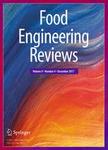版权所有:内蒙古大学图书馆 技术提供:维普资讯• 智图
内蒙古自治区呼和浩特市赛罕区大学西街235号 邮编: 010021

作者机构:Dalhousie Univ Fac Agr Dept Engn Halifax NS B2N 5E3 Canada
出 版 物:《FOOD ENGINEERING REVIEWS》 (Food. Eng. Rev.)
年 卷 期:2025年第17卷第2期
页 面:270-290页
核心收录:
学科分类:0832[工学-食品科学与工程(可授工学、农学学位)] 08[工学]
基 金:Canadian Network for Research and Innovation in Machining Technology Natural Sciences and Engineering Research Council of Canada (NSERC) [RGPIN 06081 - 2019]
主 题:Multi-objective optimization Metaheuristic Optimal operating conditions Energy Quality attributes Industrial barriers
摘 要:Food drying is a critical process in food preservation, directly impacting the quality, energy consumption, and environmental sustainability of the final product. Traditional optimization techniques, while useful, often fall short in addressing the complex, nonlinear, and multi-objective nature of food drying. Nature-inspired algorithms, which mimic biological, chemical, and physical systems, have emerged as powerful tools for optimizing these processes, demonstrating superior performance in handling multiple parameters and conflicting objectives. This review critically examines the application of various nature-inspired optimization approaches in food drying, including artificial neural networks, genetic algorithms, particle swarm optimization, and non-dominated sorting genetic algorithm II. The review highlights the theoretical underpinnings of these algorithms, their specific applications in food drying, and the advantages and limitations of each method. Recent case studies are also discussed to illustrate the practical implementation of these techniques in improving product quality, energy efficiency, and environmental impact in food processing plants. The findings highlight the potential of integrating these advanced optimization algorithms into computer-integrated manufacturing systems, driving the food drying industry toward more sustainable and cost-effective practices. Additionally, the scalability of these methods for industrial applications is critically evaluated, identifying practical barriers and suggesting pathways for future research. This comprehensive review aims to serve as a valuable resource for researchers and practitioners interested in the latest developments in food drying optimization, providing insights that are both broad and deep, suitable for a multidisciplinary audience.